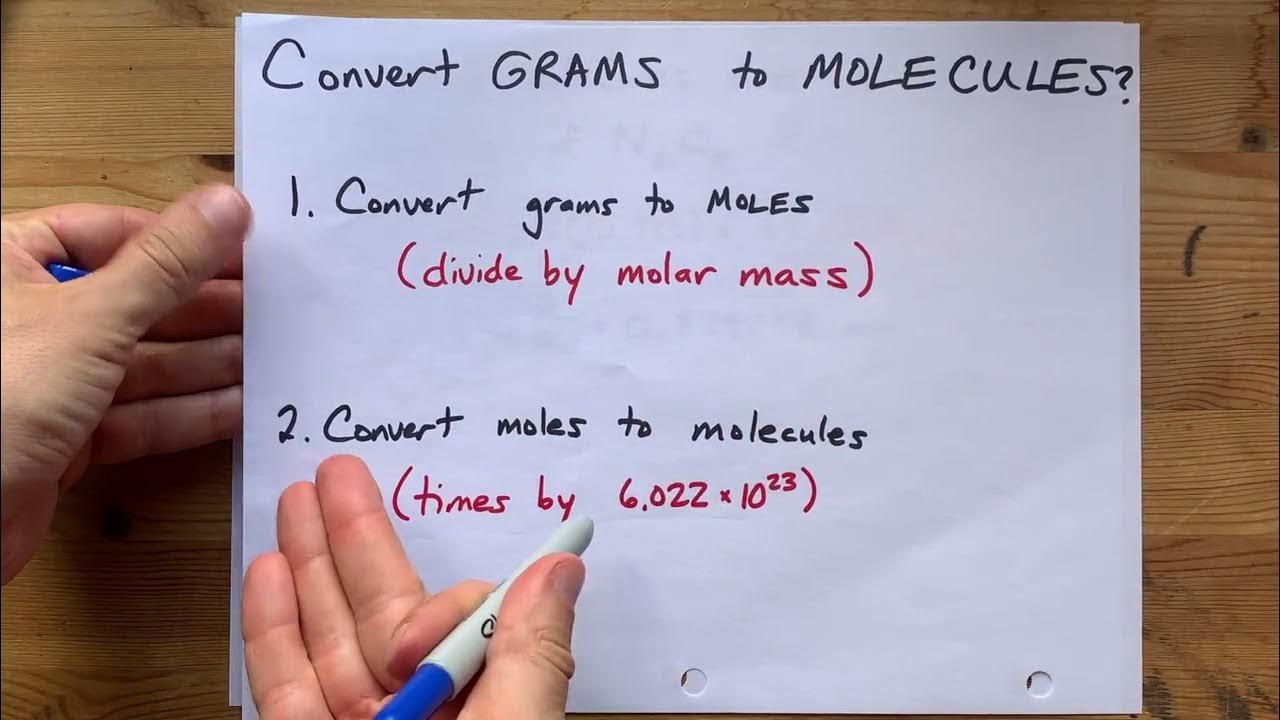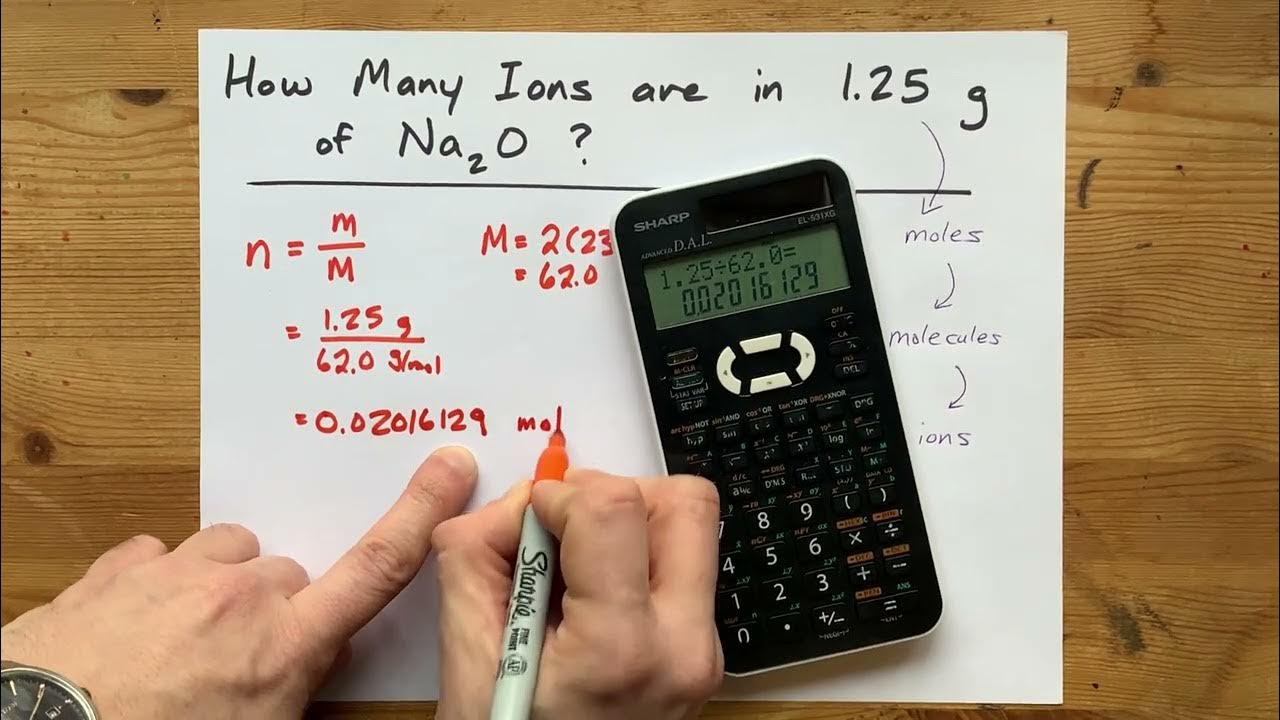How many moles are in 27.0 g of H2O ?
TLDRThe video script demonstrates the process of calculating the number of moles in a given mass of a compound, specifically 27 grams of H2O. It explains the formula for moles, which is mass divided by molar mass, and how to determine the molar mass by adding the atomic masses from the periodic table. The example calculates the molar mass of H2O as 18.015 grams per mole, then divides the given mass by this value to find approximately 1.50 moles. The importance of rounding to significant figures is highlighted, resulting in the final answer of 1.50 moles.
Takeaways
- 📏 To calculate the number of moles from grams, use the formula: moles = mass / molar mass.
- 🧪 The molar mass of a compound is the sum of the atomic masses of its elements.
- 🌊 For H₂O, the molar mass is calculated as 2 × 1.008 (for H) + 15.999 (for O).
- 🔍 Using the periodic table values, the molar mass of H₂O is 18.015 grams per mole.
- ⚖️ To find the number of moles, divide the given mass by the molar mass.
- 💡 For the given problem, the mass is 27 grams.
- 🧮 Dividing 27 grams by 18.015 grams per mole gives approximately 1.49875 moles.
- 📉 When rounding for significant figures, consider the least number of significant figures from the given values.
- 🔢 The mass (27.0 grams) has three significant figures, so the result should also be rounded to three significant figures.
- ✅ The final result, rounded to three significant figures, is 1.50 moles.
Q & A
What is the basic formula used to calculate the number of moles of a compound?
-The basic formula to calculate the number of moles is number of moles (n) equals mass (m) divided by molar mass (M), expressed as n = m / M.
What is the molar mass of water (H2O) and how is it calculated?
-The molar mass of water is calculated by adding the atomic masses of its constituent elements: 2 hydrogen atoms (2 x 1.008 g/mol) and 1 oxygen atom (15.999 g/mol), which sums up to approximately 18.015 g/mol.
Why is it important to consider significant figures when calculating moles from grams?
-Significant figures are important to ensure the precision of the calculated value matches the precision of the given data. It helps in maintaining the accuracy of scientific measurements and calculations.
How many significant figures are in the mass of water given in the script, and what does it imply for the final answer?
-The mass of water given in the script is 27.0 grams, which has three significant figures. The final answer for the moles should also be rounded to three significant figures to maintain consistency.
What is the result of dividing 27 grams of water by its molar mass?
-Dividing 27 grams of water by its molar mass of 18.015 g/mol results in approximately 1.49875 moles.
Why did the final calculated moles of water get rounded to 1.50 instead of 1.50?
-The final calculated moles of water was rounded to 1.50 because the fourth decimal place (9) is greater than 5, which according to rounding rules, requires rounding up the third decimal place.
What does the term 'molar mass' represent in the context of chemistry?
-Molar mass represents the mass of one mole of a substance, typically expressed in grams per mole (g/mol). It is numerically equivalent to the substance's molecular or formula weight.
How can you find the atomic mass of elements from the periodic table for calculating molar mass?
-You can find the atomic mass of elements on the periodic table. For the molar mass calculation, you sum the atomic masses of all the atoms in the compound's chemical formula.
What is the significance of using the correct number of decimal places when calculating molar mass?
-Using the correct number of decimal places ensures the accuracy of the molar mass calculation. It reflects the precision of the data available from the periodic table and is crucial for precise chemical calculations.
What does the script suggest about the process of converting grams to moles?
-The script suggests that converting grams to moles involves calculating the molar mass of the compound first and then dividing the given mass by this molar mass. It also emphasizes the importance of rounding to the correct number of significant figures.
Why is it necessary to perform the molar mass calculation even if it seems like additional work?
-Performing the molar mass calculation is necessary because it is a fundamental step in converting grams to moles. It ensures that the calculation is based on accurate and precise data, which is essential in scientific work.
Outlines
🧪 Calculating Moles from Grams
This paragraph explains the process of determining the number of moles in a given mass of a compound, specifically using water (H2O) as an example. It starts by introducing the concept of molar mass and the formula for calculating moles, which is mass divided by molar mass. The speaker then details how to find the molar mass of H2O by summing the atomic masses of hydrogen (H) and oxygen (O) from the periodic table. The calculation involves multiplying the atomic mass of hydrogen by two and adding it to the atomic mass of oxygen, resulting in a molar mass of approximately 18.015 grams per mole. The next step is to divide the given mass of the compound, in this case, 27 grams of H2O, by its molar mass to find the number of moles. The result of this division is approximately 1.49875 moles. The speaker emphasizes the importance of significant figures and rounding, concluding that the final answer should be rounded to three significant figures, resulting in 1.50 moles.
Mindmap
Keywords
💡moles
💡molar mass
💡atomic mass
💡periodic table
💡mass
💡significant figures
💡formula
💡calculation
💡rounding
💡precision
💡H2O
Highlights
To find moles of a compound, divide mass by molar mass.
Molar mass is the sum of atomic masses from the periodic table.
For H2O, calculate molar mass by adding 2*1.008 + 15.999.
Use the periodic table values to determine atomic masses.
Rounding of atomic masses can affect the precision of molar mass.
Molar mass of H2O is approximately 18.015 grams per mole.
Divide the given mass (27 grams) by the molar mass to find moles.
Units of molar mass are grams per mole by definition.
The calculation results in 1.49875 moles for 27 grams of H2O.
Significant figures must be considered when rounding the answer.
Rounding the moles to three significant figures gives 1.50 moles.
Rounding rules apply when determining the final moles value.
The final answer is 1.50 moles of H2O for 27 grams.
Calculating molar mass requires some initial work but is essential.
The process of converting grams to moles involves multiple steps.
The video demonstrates a practical application of molar mass calculation.
The importance of precision and accuracy in scientific calculations is highlighted.
Transcripts
Browse More Related Video

How many molecules are in 76.3 g of N2O4 ?

How many ions are in 1.25 grams of Na2O?

AP Daily: AP Chemistry (1.1)

Introduction to Combustion Analysis, Empirical Formula & Molecular Formula Problems

Converting Grams to Moles Using Molar Mass | How to Pass Chemistry

Converting Between Grams and Moles (Part 2)
5.0 / 5 (0 votes)
Thanks for rating: